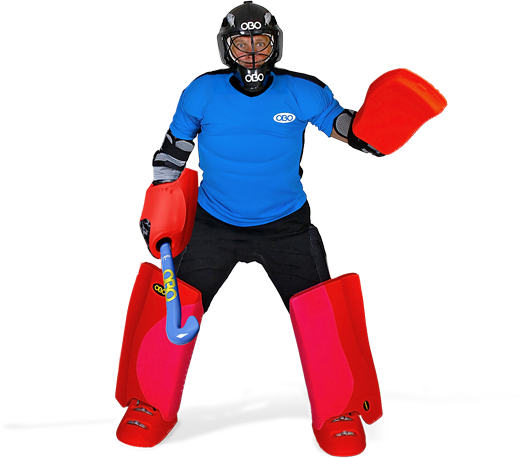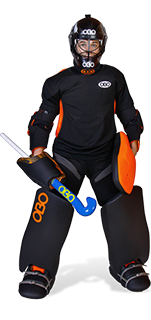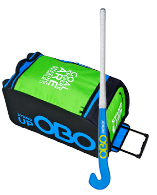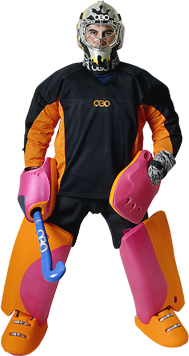KEEPERS RESOURCES

Jon’s Tips: Painting Your OBO Helmet
For all you creative OBO-ites who’ve been asking about painting your OBO helmets but aren’t sure how to go about it, here’s some ideas and advice based on recent experience. If you’re handy and keen, you can jazz up your helmet at a reasonable price on your own.
Read More
Goalkeeping in Field Hockey: 2nd Edition
A document containing all of the training tips from our old website up to September 2005 along with Jon’s expert advice in the Q&A section. Select which format of download below: Goalkeeping in Field Hockey 2nd Edition (PDF 3.07mb) OR Goalkeeping in Field Hockey (ZIP 2.57mb) Created by Pete Carling. You will need the free … Continue reading "Goalkeeping in Field Hockey: 2nd Edition"
Read More
Goalkeeping in Field Hockey
A document containing all of the training tips from our old website up to October 2000 along with Jon’s expert advice in the Q&A section. Select which format of download below: Goalkeeping in Field Hockey (PDF 1.71mb) OR Goalkeeping in Field Hockey (ZIP 1.66mb) Created by Rene Verbeek. You will need the free Adobe Reader … Continue reading "Goalkeeping in Field Hockey"
Read More
Play it forward
Whether it is the New Year, the holidays, or just the opportunity to look back, life presents us with a chance to take stock of all we have. One of my all-time favorite books (and movies) is Pay It Forward. The story revolves around a boy's class project, the concept of what we can realize if we pass on the good that comes to us. Many of us have been given a great many gifts. I'll speak for myself and say many of my greatest gifts have come through sport. In the spirit of passing on what we have and the chance to give back, I offer a list of how we can play it forward.
Read More
Rules
There was a day when any lifted shot at goal had to be controlled and cleared by the keeper. Control meant stopping the ball and dropping it straight down to clear. Keepers were required to wear gloves and essentially had to catch the shot without closing their hand on the ball and drop it down. Opposing forwards knew exactly where the first save had to go and were quick to pounce on the dropped shot. If the equipment made the job difficult enough, the consequences of bad technique made the lifted shot brutal. If your save caused the ball to be pushed or deflected you were rewarded with a penalty stroke against you. If you think that was ancient history, those rules were on the books in the 1980's.
Read More
Fixing split kickers and legguards
Recently I've received some questions from people having problems with bonded foam separating in kickers and leg guards. First off, if your leg guards or kickers are under one year from time of purchase they should be under warranty. If that fits your situation, you should take the matter up with the agent who sold you your gear. If the pads are older than a year, than try this...
Read More
Penalty Corners: Drag Flicks
Drag flicks present a huge problem for keepers in that they increase the variables that a keeper must deal with on penalty corners. Previously, the straight hit was the primary option and logging became the popular technique for dealing with the well struck shot.
Read More
Throat Guards
Recently there's been a thread on the Community section on throat guards and I'll throw my two cents in. Wearing a throat guard has nothing to do with vanity and everything to do with protection. Drag flicks, deflections and point blank chip shots make it difficult to predict how you'll be able to react and where you're going to get hit.
Read More
Agility Drills: Reflex Work
Starting with reaction training, please check Rachel's Tips on the OBO website. She has a good tip on REFLEX TRAINING. I do a lot of work with tennis balls in place of hockey balls in reaction drills but obviously that's pretty tough on your own. I like to work on aerial saves with just a helmet, hand protectors and a stick and having someone hit tennis balls with a racquet. You can further add to the reaction element by facing your back to the hitter and turning on their call be fore the shot so you have to find the ball first.
Read More
Selections: Making/Picking the Team
Selections, mention the word and the reactions for keepers competing for a spot on a team range from a rise in pulse and butterflies the size of basketballs in his/her stomach to nerves of steel and a confidence that says
Read More
Team Dynamics
In the ideal world every goalkeeper is a starting keeper. You play every minute of every game and never let in a goal. Reality tells us this isn't true. The world is filled with keepers with a wide range of skills and a limited number of teams. Not every keeper gets to play, but that's not to say that every keeper can't have an impact on his or her team's performance. How goalkeepers work together on a team is an important dynamic on and off the field.
Read More
Goalkeeping Books and Other Resources
Recently I got a question asking about books on goalkeeping. I looked on my bookshelf and quickly realized that most of the titles I've accumulated on the subject are long since out of print. Books may not yet have gone the way of the vinyl album, but increasingly other media is replacing them. Video and computers help make the printed word come alive and open a completely new library that everyone can access. The Internet can be a tremendous resource for the resourceful coach or keeper.
Read More
The Mental Game
In the quest to become better players, goalkeepers train thousands of hours, burn millions of calories and spend hundreds of dollars on equipment. Yet when it comes to the difference between becoming a good keeper and a great keeper, the answer may lie between their ears. The mental game can be a critical part to success.
Read More
Decision-Making and Team Defense
Good decision-making may be one of the most critical elements of successful team defense. It can also be one of the most difficult elements of the game to learn. Good decision-making especially as it applies to team defense depends on assessing options, developing a plan of defense, communicating the plan and executing the needed skills, usually in less than five seconds.
Read More
Equipment: Part 2

Last tip we made a start to covering goalkeeper equipment. We talked about what to look for, how to take care of it and specifically looked at equipment bags, kickers and leg guards. In this second part, we'll look at helmets, hand protection, body pads, pants and assorted other items.
Read More
Equipment: Part 1

One of the most important parts of any keeper's game is his (or her) equipment. Good equipment, effectively used, is one of the cornerstones of goalkeeping. When a keeper chooses his equipment, he's choosing a style of play. That's an important choice. Unfortunately, that's not a choice that all keepers get to make for themselves. Many keepers are provided with kit through their clubs or schools. Other keepers are responsible for providing their own equipment. Whether you or your team is responsible for your equipment, money can be an issue. You can't spend what you don't have. Having said that, there are ways to get the most out of the kit you do have and a number of things to consider when selecting new equipment.
Read More
Penalty Strokes
I am often asked questions like the following: Can you please send me information on strokes. I am a goal keeper and had a stroke against me on Wednesday and I missed it. I think it was probably because I didn't dive but rather reached out for it with my leg. How do I know when to dive or how, and how do I read them so that I can at least dive in the right direction. Can you also tell me how to build up my confidence on diving so that I can dive correctly.
Read More
Training on your own
We receive a lot of questions about training on your own and training programs. I will always refer people to check the other information on this web site. Rachel and I both have covered a variety of issues on the topic. In addition, the subject is also covered in the previous Q&A section of the website. Having said all that, let's talk about it some more.
Read More
Penalty Corner Defense: Logging
We get a lot of questions about penalty corners, especially lying down on corners. Laying down, or logging, is only one technique that a keeper can apply in the context of his, or her, team's penalty corner defence. No one technique, or type of defence, will be successful against every corner attack. This month's tip focuses on some concepts of penalty corner defence and specifically one technique for logging.
Read More
Basic Positions: Angles
The concept of angles builds on most effectively using your ready stance to position yourself between the shooter and the goal. In the one ball, one shooter world that can be a pretty simple concept. Throw in variables like your size, your reaction time, passing options and players in the way, and things get complicated. Complicated doesn't mean impossible, a keeper just needs to take these things into consideration and put them to use.
Read More
Basic Postions: A Ready Postion
Before a keeper can make a save, he's got to be in a place where he can even attempt to make a save. That is the crux of basic positioning. A goalkeeper's primary responsibility revolves around keeping a ball out of the goal. Take a good look at that goal, the one that is seven foot by twelve foot, 84 square feet. Throw in the fact that object to be stopped is a little more than seven inches in circumference and weighs about eight ounces and that the object in question can travel more than 100 miles an hour... a quick show of hands... who thinks this is going to be an easy position? Nobody ever said it was going to be easy, but good basic positioning can make goalkeeping an easier position.
Read More
Young Goalies
One of the most important factors in the development of a goalkeeper is getting good, basic instruction early. Too many times, the first specialised instruction a keeper receives is after he/she has been identified as an elite keeper.
Read More
Aerial Balls
As goalkeeping continues to be reinvented, the most recent changes have come in the aerial ball. Today's keeper sees more hard, lifted shots from different angles than ever before. Fortunately, he is better equipped and has new tools and skills for meeting the task. No offsides, drag flicks and reverse stick chips have increased the number of chances above the waist that a keeper has to defend. Upper body pads and hand protectors now give him effective protection to make those plays.
Read More
Training Programs
Last tip we talked a little about off-season conditioning and training. Since that time, I've gotten a lot of questions about specifics for a training program. They range from sprint workouts, to length of program to types of agility drills. First off, there is no perfect one size fits all training program for every keeper.
Read More
Off Season Training
To borrow a line from Shakespeare, "Now is the Winter of our discontent." For keepers in the Northern Hemisphere, Winter means snow, sleet and a break from outdoor hockey. For those in Southern Hemisphere, Summer and the heat provide the break. Wherever you are and whatever the time of year, at some point you're going to have a break in your hockey season (my source of discontent). As the holidays approach, I've received a lot of questions about off-season training programs and activities.
Read More
Slide Tackling
There have been a lot of questions about what to do in situations where a keeper is faced with a forward bearing down on him or her alone. Most centre around what the keeper should do. There isn't a text book answer that says, "If the forward enters the circle with a five yard gap between him and his defender, at a 45' angle to the goal and the ball on his front stick, the keeper extends his body in a prone position to his strong stick side at a rate of speed of 15 mph, bisecting the path of the ball at his midsection." That's certainly one way of handling the situation, but the fact of the matter is there isn't any one way to play any one situation, especially one on ones with the keeper and a forward.
Read More
Kicking
There is no more essential skill to a keeper in the game of hockey, than kicking. Just as a field player must have stick skills, a keeper must have kicking skills. The importance of this most basic of skills is often overlooked. People tend to think all a keeper need do is worry about saving the ball. A keeper can make all the saves in the world in a game, but if he can't clear the ball, he almost assures himself of allowing goals.
Read More
Kickers
No matter how talented a carpenter is, with bad tools he'll be hard pressed to produce a good product. The same holds true for a keeper. A good keeper with bad pads has a hard job, made harder.
Read More
Kicking Drills
When you're working on skills, it's important that you isolate them so that you can evaluate technique and success. Skill work is different than situation work. When I work with keepers in situation drills, there are a number of skills they can use in a situation and be successful. When we work on skills, we're focusing on specific form and results. Any time you work on skills, there are a couple of things to keep in mind.
Read More















